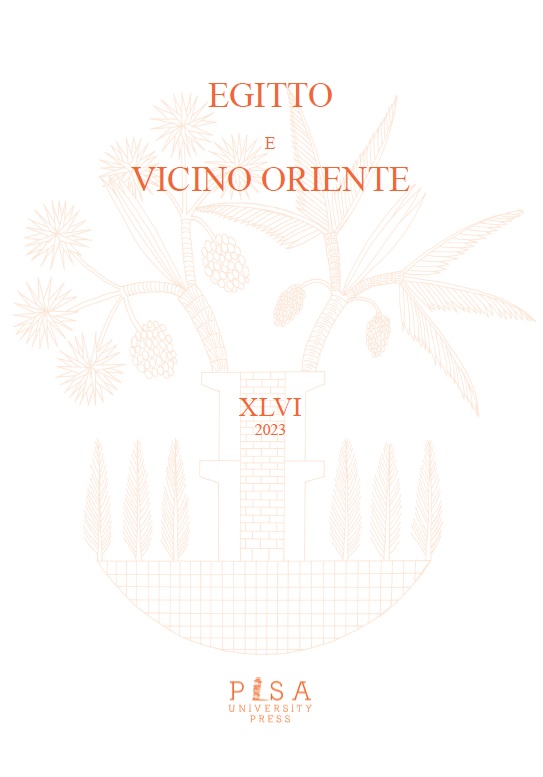
The pectoral published here first came to my attention while searching for objects relating to Wenennefer, the well-attested 19th Dynasty High Priest of Osiris at Abydos.
It was sold at Sotheby’s New York in 1994 and entered the private collection of Carl A. Minning Jnr. where it remains today. The brief entry in the auction catalogue includes a photograph of one side only and ascribes the pectoral to an individual named Wenennefer. However, after receiving photographs of both sides, an inspection of the inscriptions revealed that Wenennefer as a personal name is nowhere to be found and the attribution in the auction catalogue was mistakenly based on the occurrence of the homonymous epithet of Osiris inscribed on the recto.
Despite the lack of an owner’s name, the unique combination of pictorial and textual elements on both sides, including two uncommon epithets, sets this pectoral apart from most others and therefore is worthy of further analysis..
The Ancient Egyptian scenes with anthropomorphized animals, attested mostly during the Ramesside Period and in the Theban region, have been the subject of diverse interpretations in the Egyptologist literature, but none of them is subject to a consensus. The donkey is not the most featured creature in that iconography. However, it is worth noting that, out of the ten recorded occurrences, four depict this animal playing a harp. Another interesting feature of this motif is the fact that it is known in other cultures, from the Proto-Elamite glyptic to the medieval and modern Occidental art. The author investigates on this motif and explores the interpretations and comments made on this motif by Egyptologists and specialists of these other cultures. This detour does not so much deliver definite answers, as it provides reflexions on the way of using the comparative method: it can inspire new hypotheses, but also raises awareness about our own modern prejudices, and reminds that the interpretation of each example of a motif should rely on a thorough study of its elements and of its context.
The remains of B1200, a series of labyrinthine mudbrick ruins appertaining to the sacred complex of Gebel Barkal and covering an area of 45×70 m, do not correspond to a single cohesive structure but to several overlying buildings belonging to different historical phases. Reisner and Kendall identified traces of the site’s occupation during the 25th Dynasty, the Napatan and Meroitic periods.
Via the collection of the available archaeological material and its analysis in both Nubian and Egyptian contexts, the following paper aims to validate B1200’s palatial function not only highlighting the importance of its continuous restoration but proposing its identification with the Egyptian typology known as residential palace.
Throughout the second half of the first millennium BCE, Memphis was the major metropolis of Egypt. Despite this, there has been a lack of research into the familial connections among the temple personnel of the city. This study seeks to reconstruct the genealogy of a notable priestly family, labelled here “the House of It(A)”, which can be documented for seven generations between the late eighth century BCE and the mid-sixth century BCE. A comprehensive review of the available sources revealed that this family had maintained their roles in local religious institutions throughout all known generations. Marrying within their temple community strengthened the family’s authority and carried their lineage onward. The Ptah temple complex, the city’s main sacred space, was paramount to their reputation and prosperity. Another area where activities were conducted by this family was the Memphite necropolis, mainly the region between Saqqara and Giza. In addition, some members of the family, akin to many of the state officials at the time, managed both the temple and royal palace affairs.
During the excavations at Central Dra’ Abu el-Naga (CDAN), numerous objects and tomb assemblages were unearthed including the funerary cones. A number of cones were associated either with tombs in Dra’ Abu el-Naga (DAN) or tombs in other places in the Theban Necropolis. This article will shed light on three burial cone types that, according to the author, were previously unknown and had not been identified in the work of Davies/Macadam, Daressy, nor the Marquis of Northampton.
The modern settlements of El-Matariya and Ain Shams are located to the north-east of Cairo, covering the cemetery of Ancient Heliopolis. This necropolis contained many tombs from the Old Kingdom onwards and continued to be used into the Late Period. The core of this research is to study in detail the forgotten excavation at 5 Al Mashrooa St. from Terat El-Jabel الجبل ترعه شارع / المشروع شارع and the mostly unpublished objects that stem from these excavations, which are kept in El-Matariya’s storerooms and Grand Egyptian Museum. During the research, many unpublished Excavations and objects were remarked. These objects contain important archaeological information that needs to be published to introduce new
information about the history of Heliopolis.
Among the papyri acquired by the Rijksmuseum van Oudheden from the collector Giovanni d’Anastasi in 1828, there are some interesting amuletic papyri. Three of them have not been published until now: two amuletic papyri, AMS 59d (pLeiden I 359) and AMS 59b (pLeiden I 357), and a linen amulet, AMS 59a (Leiden I 356). The three amulets present several differences: AMS 59a is quite long and extensively decorated, as the amuletic papyri of the Late Period; on the contrary, AMS 59b is very simple and bears only one image; AMS 59d presents some images that can be interpreted in the context of the exorcistic practice related to the goddess Sekhmet and her demons. These amulets show many similarities with other amulets from the Late and Ptolemaic Period, being good representatives of the magical practice of the period. The images are based both on the iconographic repertoire typical of this kind of objects and on the innovations introduced during the Late Period. Given also their excellent state of preservation, the objects are an interesting addition to the group of the already known amuletic papyri.
Following the availability of satellite imagery open access repository such as Landsat ETM (enhanced thematic mapper), this paper intents to re-evaluate the archaeological panorama of Central Arabia with particular regard to the Bronze Age. Sporadic archaeological surveys and field research were basically devoted to the oases of Yabrin and al-Kharj, demonstrating the richness of a Bronze Age at least in these two particularly rich territorial units. Nonetheless, a remote sensing geoarchaeological approach firstly aimed to the depiction of the paleo landscape allows to define a systematic approach based on a predictive model, able to detect the proper amount of Bronze Age structures (mainly funerary) that dotes the region of Central Arabia following precise patterns linked to the availability of peculiar resources and pathways. Thus, in light of this first comprehensive depiction of the Bronze Age panorama, Central Arabia can be better revaluated within the Arabian Bronze Age cultures.
The scant evidence of loyalty oaths sworn to the Egyptian kings by the Syro-Palestinian rulers during the Late Bronze Age should not be considered proof of an imposition of some sort of legal procedure by the Egyptian administration. Instead, these loyalty oaths ought to be understood as both political and symbolic manifestations of Egyptian suzerainty and Syro-Palestinian subordination, within the context of a clash of bureaucratic power and indigenous socio-politics based on patron-client relationships.
We publish a Middle Babylonian tablet written in landscape orientation with 28 aḫû-omens, i.e. extra serial entries, from the Middle Babylonian series alamdimmû copied from a tablet from Nippur. Two scholars collated (igi.kár) the writing. The scribe of the tablet is Šamaš-šar-ilāni, the son of Zākiru, a ša rēši-official of king Kurigalzu, i.e. either Kurigalzu I (?–1383 BCE) or II (1335–1309 BCE). Thus, this tablet is not only the earliest datable omen tablet from the series alamdimmû. It also provides proof of the “older”, i.e. Middle Babylonian, series called alamdimmû that circulated among the scholars long before Esagil-kīn-apli reworked both series sa.gig and alamdimmû in the eleventh century BCE to establish a new edition that was then commonly used during the first millennium BCE.
The article shows how Ishmael’s genealogy, recorded in Gen 25,12-18, fulfils a specific need of the Jerusalemite priestly class during the Persian period: to ensure the constant supply of incense, necessary for the temple’s cultic functions. Through the analysis of biblical and extra-biblical sources, the hypothesis will be advanced that including Qedar and Tema within the Ishmaelite line was functional in addressing the anti-endogamic policies promulgated in Yehud by the Nehemian current. It will be proposed that through the inclusion of the Ishmaelites in the Abrahamic lineage, the Sadocite elite attempted to safeguard the possibility of establishing economic ties through marriages with the Qedarite groups that controlled caravan traffic in the northern sector of the Incense Route during the Persian period.
